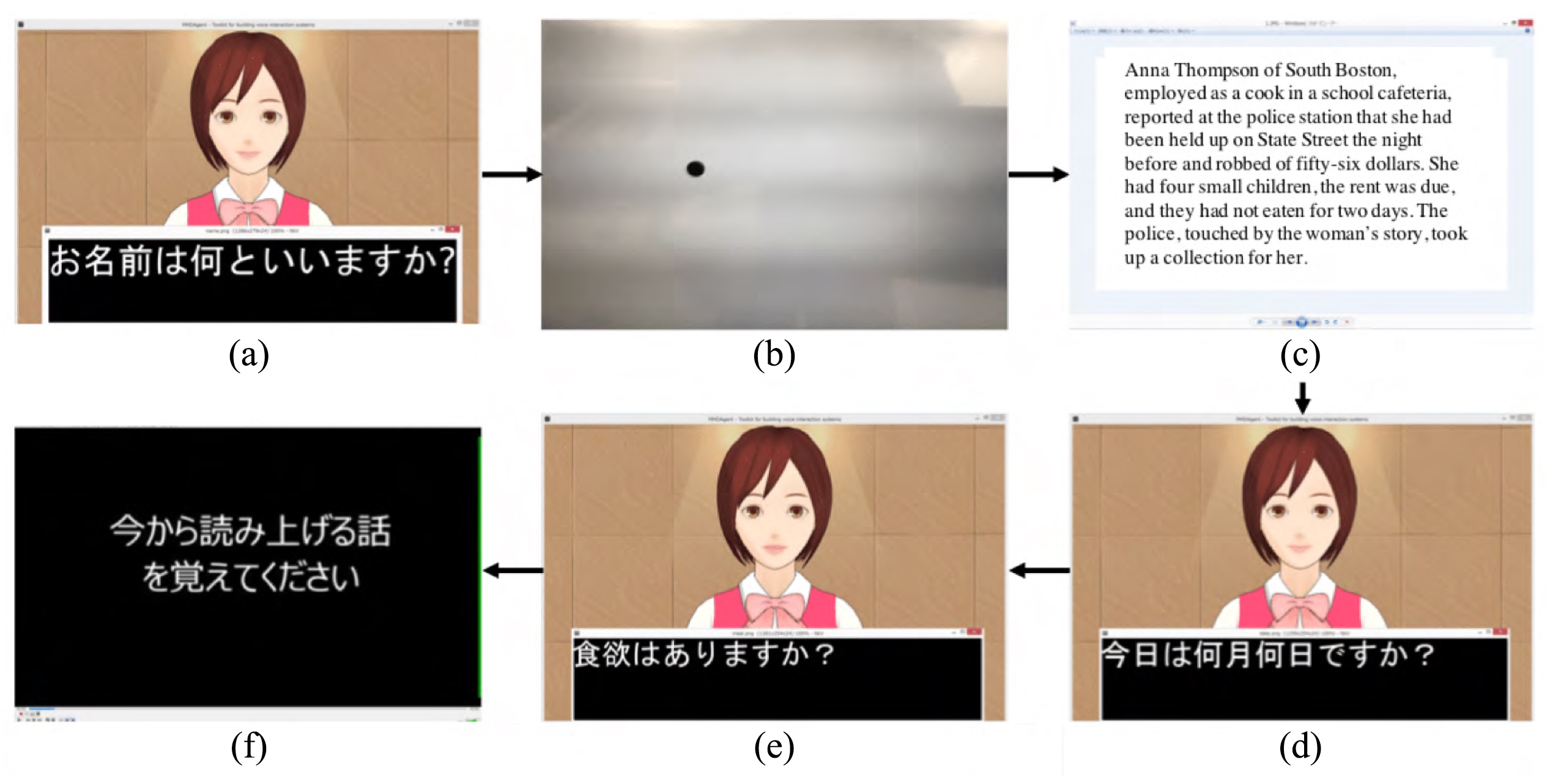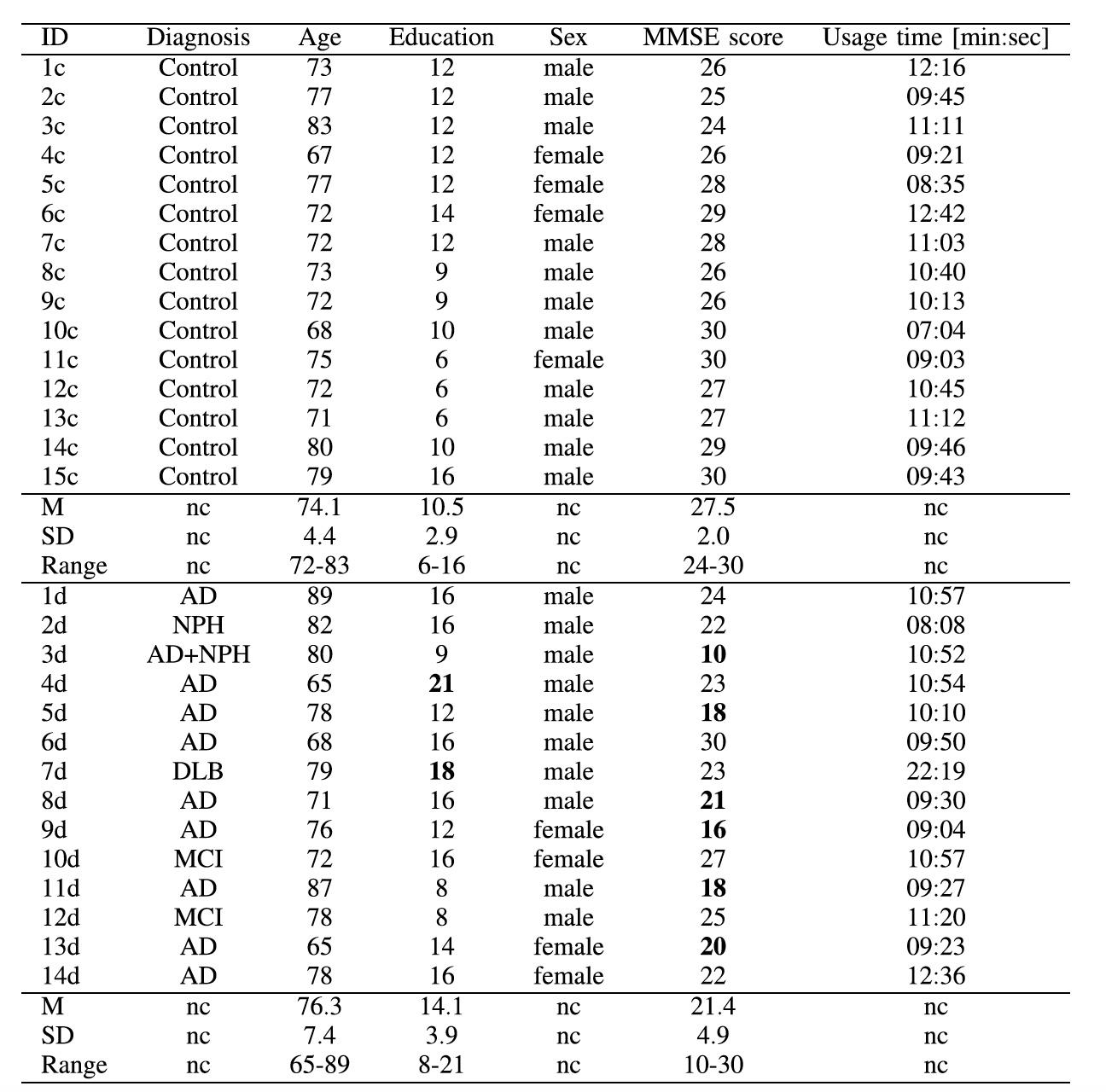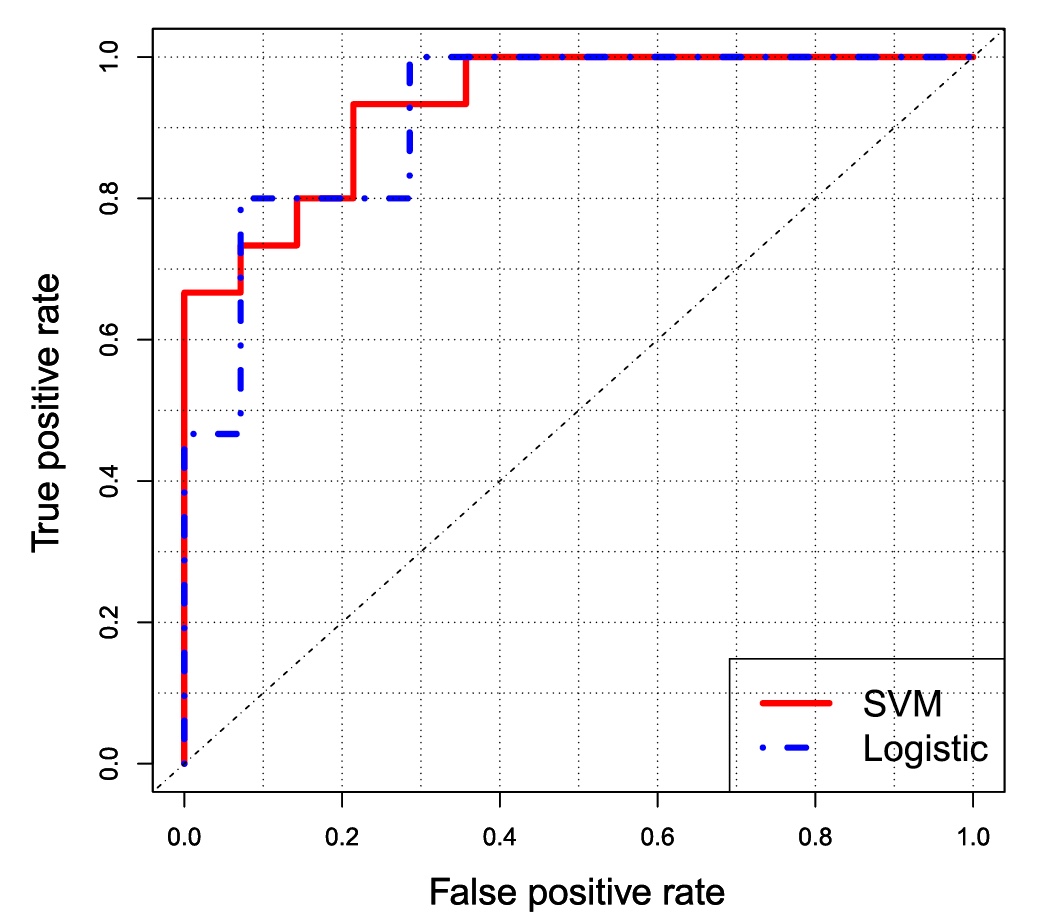Do not lose yourself: a new method of diagnosing dementia

Someone will say family, work, friends, character, talents, etc. to the question “what makes you?” But the most universal for all options is our mind. It is he who makes us who we are. However, like any other organ or system in the human body, the brain is not eternal. Losing your hand is terrible, but losing your mind is even worse, especially if a person’s career has always relied precisely on mental activity, that is, he was a scientist, teacher, writer, philosopher, etc. Degenerative processes in the brain, often referred to as dementia, are easiest to treat in the early stages of the disease. But for this you must first diagnose this very dementia, which is a very difficult task.
Today we will talk about the study of a new method of diagnosing dementia using machine learning, visual / sound analysis and a virtual interlocutor-diagnostician. How effective this method is and what, previously unknown, symptoms, he discovered, we learn from the report of scientists. Go.
Etiology of dementia
Definition of dementia says that it is acquired dementia, expressed in reducing a person's ability to absorb new knowledge, skills and information, as well as in the problem of using previously acquired knowledge, skills and information.
First of all, it is worth noting the word "acquired", that is, the disease, more precisely a group of diseases, are not inborn. Most often, dementia is associated with older people. We have all heard about diseases like Alzheimer's disease, cerebral atherosclerosis, less often about Pick's disease. All these terrible diseases fall into the category of dementia.

MRI scans and illustrations of the difference between a healthy brain and Alzheimer's disease: a significant decrease in the hippocampus, which is responsible for the formation of new memories; shrinkage of the cortex negatively affects the areas responsible for thinking, planning and memorizing; brain ventricles are enlarged.
People with dementia forget who they are; they cannot remember even the brightest events in their lives; they often do not remember what happened a few minutes ago. Their behavior is sometimes inadequate, irrational, sometimes reminiscent of the state of delusions and even hallucinations. This ailment bears a lot of grief and problems not only for the patient himself, but also for his relatives around him. The realization that a person whom you have known all your life as intelligent and insightful suddenly begins to lose himself, this is a heavy burden. No matter how much time you spend on retelling the whole patient's biography, on interpreting what works around you, he will forget it anyway, not after 5 minutes, so in an hour.
How to prevent dementia? The answer to the absurd is simple - to lead a healthy lifestyle. Harmful habits, lack of normalized physical activity and, most importantly, regular warm-up for the mind become the foundation for the development of dementia when it reaches old age. Of course, there are types of dementia caused by other diseases or injuries. In such a situation, everything also depends on the primary treatment of the root cause, since dementia is already an indirect, a kind of strong symptom.
Now the scientist of the world pays much more attention not to the treatment of dementia, but to its prevention. For this it is necessary to identify this disease at the earliest stages of development. The sooner it is identified, the more likely it is to stop its development in the future. There are many diagnostic methods, and each is good.
The heroes of today's history are scientists who have decided to use computer technology in order to hedge and help physicians in such a complex task as diagnosing the early stages of dementia. Current disease detection methods are coupled with blood tests, MRI scans, cerebrospinal fluid analysis, and cognitive tests that are carried out by teams of specialists. It works, but it takes a lot of time and money, which the patient may not have.
Virtual interlocutor
When it comes to the diagnosis of diseases that manifest verbal, lexical and physiognomic changes, it is important to catch these deviations from the norm. It is also important to position the patient to dialogue with the diagnostician. When this diagnostician is a living person, there are not so many problems, but if the role of the doctor is played by a computer avatar, then certain features of patients must be taken into account.

The interface of the program for the diagnosis of dementia.
First of all, it should be noted that the main avatar was the program MikuMikuDance - animation editor, with which a person can create three-dimensional animated videos. Given the country of origin of this study - Japan - the language of this program is also Japanese.
The system of a virtual interlocutor is able to recognize speech, manage dialogs, convert speech to text and change the behavior of an avatar, adapting to the subjects.
Practitioners of medicine participated in the process of creating the system and advised programmers on some of the subtleties of working with older people acting as test subjects in this study. First, the avatar's speech speed was slightly reduced to improve perception to 3.38 words per second. Subtitles are displayed on the screen (Gothic font, letter size is 80) in case the subject has problems with speech perception (this may be due to both dementia symptoms and banal hearing problems). Also, the avatar's high tone was initially lowered by 0.7%.
The avatar itself is a three-dimensional model of a young girl on a beige background without any images, as they could distract subjects from the process. When the subject utters a phrase, the avatar nods in response if he recognizes it.
Stages of diagnostics
In total there are 6 stages, each of which has its own task (in the image above marked with the letters a, b, c, d, e, f).
I. Presentation ( a ), when the system greets the subject, calls his name and asks the following questions:
- What is your name?
- How old are you?
According to the researchers, this, though small, introductory dialogue reduces the psychological stress of the subjects, and also introduces them to the way the system works.
Ii. Visual tracking ( b ), when a black dot appears on the screen, which the subject must follow for two minutes. This test allows you to analyze the response delay.
Iii. Reading ( s ) when the Wechsler memory test (WMS-R) is performed. The text appears on the screen, which the subjects read out loud.
Iv. Common to all questions ( d ), when all subjects are asked 3 questions: what day is it today (Q1), tell something about yourself (Q2) and how did you get here, that is, to the place of the test (Q3).
V. Random questions ( e ) when the avatar asks 5 questions that are randomly selected by the system of 13 prepared in advance:
- What time of the year is it?
- What is the year now?
- Who is the prime minister of Japan?
- Are you left handed or right handed?
- Do you sleep well?
- What is your appetite?
- Please tell us about a recent event that was stressful for you.
- Please tell us about Khibari Misora (famous Japanese singer).
- Please tell us about Yujiro Ishihara (famous Japanese actor).
- Please tell us about Shigeo Nagashim (a famous Japanese baseball player).
- What is your hobby?
- What is your favorite song?
- Please tell us about your family.
Vi. Retelling ( f ), when the system loses the record on which the psychologist reads the text, and the subjects must retell this story.
An important feature is the pauses that the system makes before asking the next question: 10 seconds for simple questions with short answers and 15 seconds for complex questions. For interaction between people, such pauses are quite long. However, in order for the system to recognize speech even with a low amplitude, it was decided to use longer pauses.
The whole process of communication between the subject and avatar-diagnostician was recorded on the camera for further analysis of the image and sound (physiognomy and speech peculiarities of each subject).
In this study, 33 subjects participated. 16 (12 men and 4 women) of them already have clinical evidence of dementia, and the remaining 17 (13 men and 4 women) are healthy. Both groups passed tests separately from each other in different rooms.

The data of the subjects. Marks: AD - Alzheimer's; NPH - normal pressure hydrocephalus; DLB - dementia with Levi calves; MCI - mild cognitive impairment.
The table above contains brief information about each subject: presence / absence of dementia, age, education rate, gender, MMSE score (short scale for assessing mental status - questionnaire with 30 questions) and time spent on the test with avatar diagnostician.
Further, out of 33 participants in the study, four were excluded, since two of the group with a diagnosis did not yet have clinically confirmed results, and two from the healthy group scored 22 and 23 points on the MMSE, which is lower than the pass.
The MMSE test already serves as a good support, since its results largely correspond to the presence or absence of a diagnosis in the subjects. The average score of a healthy group is higher than that of a group with dementia.
The received audio and video data was run through the recognition system for the presence or absence of dementia symptoms, which was built on the basis of two machine learning algorithms. The main models of classifiers are logistic regression and the support vector method.
The main criteria for assessing the condition of the test steel:
- Gap is the pause between the avatar's question and the response of the subject;
- F0cov - coefficient of variation of the spoken utterances;
- Smile is an indicator of the number of frames in the recording of the subject on which he smiles;
- h1a3 - the difference between the amplitudes of the first harmonic (h1) and the third formant (a3), which allows to determine the "quality" of the voice;
- Power - voice amplitude;
- Verbs - the verbs used by the subject;
- Corr. - corrections during speech;
- # of pauses - the number of pauses between sentences;
- Prop. of pauses - the proportion of pauses during the response;
- Hesitations - the coefficient of uncertainty during the response;
- Tokens - speech tokens (number of words);
- Nouns - nouns;
- AR - articulation rate;
- TTR - the ratio of unique words and repeating;
- D value - diversity index.

P-value (P-value) - in this case, the lower this indicator, the greater the difference between the results of the two groups of subjects. Cohen's D or the size of the effect shows how strongly the influence of one or another criterion on the formation of the final result, that is, the diagnosis. Trend - shows the trend vector in the group with dementia.

The table above shows the relationship between the “pause” criterion indicator and the type of questions, as well as the P-value of a healthy group and a group with dementia.
As can be seen from these data, the simplest question for subjects with dementia was the question - how did you get here, that is, to the place of the test? This is due to the fact that this information relates to events of the recent past.

ROC curve for assessing the quality of classification by logistic regression and the support vector method.
The accuracy of system diagnostics based on logistic regression was 79%, and based on support vectors - 83%.
For a more detailed study of the study can read the report of scientists.
Epilogue
These results indicate a fairly high accuracy of this unusual diagnostic method, which combines a dialogue with a virtual interlocutor, sound and visual analysis and machine learning.
Of course, there may be complaints about this study. So, many believe that using the P-value allows you to manipulate the results of experiments, adjusting them to the desired, thereby discrediting it. However, researchers argue that their work is based on real measurements. Let's hope this is true. After all, such studies, if conducted honestly and with great attention, are of great importance for humanity.
I am writing this article not so much with the purpose of sharing information regarding the above described research, but for the sake of the next, but not superfluous, announcement of the problem that is often not noticed. Dementia is not just "senility", it is a serious problem for both the patient and his relatives. Unfortunately, the problem of dementia is not so vividly discussed in the post-Soviet countries. However, by paying attention to the development of a fast, cheap and effective method for the preventive diagnosis of dementia, it is possible to improve the quality of life of millions of people. Not to mention the social benefits. After all, many people suffering from dementia are not only able to do something for society and / or at least for their relatives, but they also want it. But because of the disease, they become hostages of their own mind, which, by unfortunate coincidence of circumstances and factors, cannot work as before. A person whose consciousness returns from non-existence only for a moment in order to realize his inability to think and feel this horror normally, having expressed it not even verbally, but with a glance - such a “spectacle” allows us to understand one thing - without our brain, we are just bags of meat and bones .
I will not argue with the fact that this material is not as informative as we would like. But, I repeat, this study is only a reason to express the thought of a person who is directly confronted with dementia every day. As I said earlier - explanations, reminders, logic, hints and other things work only with a healthy person. Dementia takes away from a person not only memory and the ability to think sensibly, it takes away from him a person.
Therefore, I will say briefly - take care of those you love, for you never know when you can lose them.
Thank you for staying with us. Do you like our articles? Want to see more interesting materials? Support us by placing an order or recommending to your friends, a 30% discount for Habr's users for a unique analogue of the entry-level servers that we invented for you:The whole truth about VPS (KVM) E5-2650 v4 (6 Cores) 10GB DDR4 240GB SSD 1Gbps from $ 20 or how to share the server? (Options are available with RAID1 and RAID10, up to 24 cores and up to 40GB DDR4).
VPS (KVM) E5-2650 v4 (6 Cores) 10GB DDR4 240GB SSD 1Gbps until December for free if you pay for a period of six months, you can order here .
Dell R730xd 2 times cheaper? Only we have 2 x Intel Dodeca-Core Xeon E5-2650v4 128GB DDR4 6x480GB SSD 1Gbps 100 TV from $ 249 in the Netherlands and the USA! Read about How to build an infrastructure building. class c using servers Dell R730xd E5-2650 v4 worth 9000 euros for a penny?
